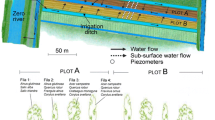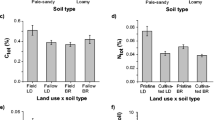Abstract
In land-based wastewater treatment systems (LTS), denitrification is an important nitrogen removal process. We investigated the factors limiting the denitrifying population in a forested LTS, by studying the individual and combined effects of soil aeration, water content, nitrate and carbon on denitrification enzyme activity (DEA). The size of the soil denitrifying population in the LTS appeared to be limited by soil aeration, and limiting oxygen availability increased the denitrifying population above that observed in the field. Furthermore, we found that wastewater irrigation altered the short-term response of denitrifiers to anaerobic soil conditions. Under low oxygen conditions, denitrifiers in the wastewater-irrigated soils produced enzymes sooner and at a greater rate than soils without a history of wastewater irrigation. We propose that the size of the denitrifying population cannot be expected to be large in free-draining, coarsely textured soils even when provided with additional nitrogen and water inputs.
Similar content being viewed by others
Author information
Authors and Affiliations
Additional information
Received: 11 October 1999
Rights and permissions
About this article
Cite this article
Barton, L., Schipper, L., Smith, C. et al. Denitrification enzyme activity is limited by soil aeration in a wastewater-irrigated forest soil. Biol Fertil Soils 32, 385–389 (2000). https://doi.org/10.1007/s003740000267
Issue Date:
DOI: https://doi.org/10.1007/s003740000267




